
Table of Contents
Early detection is crucial for improving survival rates and reducing the burden of this disease. Researchers are increasingly focusing on identifying biomarkers that could aid in the early detection of cervical cancer, providing a more effective and less invasive approach than current screening methods. This article explores the current state of research on biomarkers for cervical cancer, their potential benefits, and the challenges involved in their development and implementation.
The Importance of Early Detection
Current Screening Methods
The most common screening methods for cervical cancer are the Pap smear (or Pap test) and the HPV (human papillomavirus) test. While these methods have significantly reduced the incidence and mortality of cervical cancer, they have limitations:
- Pap Smear: Detects precancerous or cancerous cells in the cervix but requires skilled personnel for interpretation and has a risk of false-negative results.
- HPV Test: Identifies the presence of high-risk HPV strains that are associated with cervical cancer but does not distinguish between transient infections and those likely to progress to cancer.
Benefits of Biomarkers
Biomarkers could revolutionize the early detection of cervical cancer by providing:
- Greater Accuracy: More precise identification of precancerous changes and cancer.
- Early Intervention: Detection of changes at the molecular level before visible abnormalities appear.
- Non-Invasive Testing: Potential for less invasive testing methods, such as blood or urine tests.
- Personalized Medicine: Tailoring prevention and treatment strategies to individual risk profiles.
Types of Biomarkers Under Investigation
Genetic Biomarkers
Genetic biomarkers involve the detection of specific genetic alterations associated with cervical cancer. Key areas of focus include:
- Oncogenes and Tumor Suppressor Genes: Mutations or changes in expression of genes such as PIK3CA, PTEN, and TP53.
- HPV Integration: Integration of HPV DNA into the host genome, which can lead to genetic instability and cancer development.
Epigenetic Biomarkers
Epigenetic changes, such as DNA methylation and histone modification, can regulate gene expression without altering the DNA sequence. Researchers are exploring:
- DNA Methylation Patterns: Aberrant methylation of tumor suppressor genes (e.g., CADM1, MAL, and DAPK1) that can serve as early indicators of cervical cancer.
- Histone Modifications: Changes in histone acetylation and methylation that affect chromatin structure and gene expression.
Protein Biomarkers
Proteomic studies aim to identify proteins that are differentially expressed in cervical cancer. Potential biomarkers include:
- Serum Proteins: Elevated levels of proteins such as SCC-Ag (squamous cell carcinoma antigen) and CYFRA 21-1 (cytokeratin fragment) in blood samples.
- Tissue Proteins: Proteins like p16INK4a, which are overexpressed in HPV-associated lesions and can indicate high-grade cervical intraepithelial neoplasia (CIN).
Metabolomic Biomarkers
Metabolomics involves studying small molecules (metabolites) in biological samples. Changes in metabolite profiles can reflect underlying disease processes. Researchers are investigating:
- Metabolic Pathways: Alterations in pathways like glycolysis, the citric acid cycle, and amino acid metabolism in cervical cancer cells.
- Specific Metabolites: Metabolites such as lactate and certain lipids that are found in higher concentrations in cancerous tissues.
Advances in Biomarker Discovery
High-Throughput Technologies
Advancements in high-throughput technologies, such as next-generation sequencing (NGS), mass spectrometry, and microarray analysis, have accelerated the discovery of potential biomarkers. These technologies enable comprehensive analysis of genetic, epigenetic, proteomic, and metabolomic changes in cervical cancer.
Bioinformatics and Data Integration
The integration of bioinformatics and systems biology approaches allows researchers to analyze large datasets and identify patterns associated with cervical cancer. Machine learning algorithms and artificial intelligence (AI) are increasingly used to predict disease risk and outcomes based on biomarker data.
Validation and Clinical Trials
Identified biomarkers must undergo rigorous validation through preclinical and clinical studies to ensure their reliability and effectiveness. Multi-center clinical trials are crucial for assessing the performance of biomarkers in diverse populations and settings.
Challenges and Future Directions
Sensitivity and Specificity
One of the main challenges in biomarker research is achieving high sensitivity and specificity. False positives and false negatives can lead to unnecessary anxiety, overtreatment, or missed diagnoses. Combining multiple biomarkers (biomarker panels) may enhance diagnostic accuracy.
Accessibility and Cost
For biomarkers to be widely adopted, testing methods must be affordable and accessible, particularly in low-resource settings where cervical cancer prevalence is highest. Developing cost-effective assays and simplifying testing procedures are critical steps.
Ethical and Regulatory Considerations
Ethical issues, such as informed consent and data privacy, must be carefully managed in biomarker research. Additionally, regulatory approval processes can be lengthy and complex, requiring robust evidence of clinical utility and safety.
Personalized Screening and Treatment
Future research may focus on personalized screening strategies that consider individual risk factors, such as genetic predisposition, lifestyle, and environmental exposures. Personalized approaches could improve early detection and prevention efforts.
Conclusion
The quest to identify reliable biomarkers for the early detection of cervical cancer holds great promise for improving outcomes and reducing the global burden of this disease. Advances in high-throughput technologies, bioinformatics, and clinical research are paving the way for the development of precise, non-invasive, and cost-effective diagnostic tools. While challenges remain, continued collaboration among researchers, clinicians, and policymakers will be essential in translating these discoveries into clinical practice. As the field progresses, biomarker-based screening could become a cornerstone of cervical cancer prevention and early intervention, offering hope for better health and survival rates for women worldwide.








